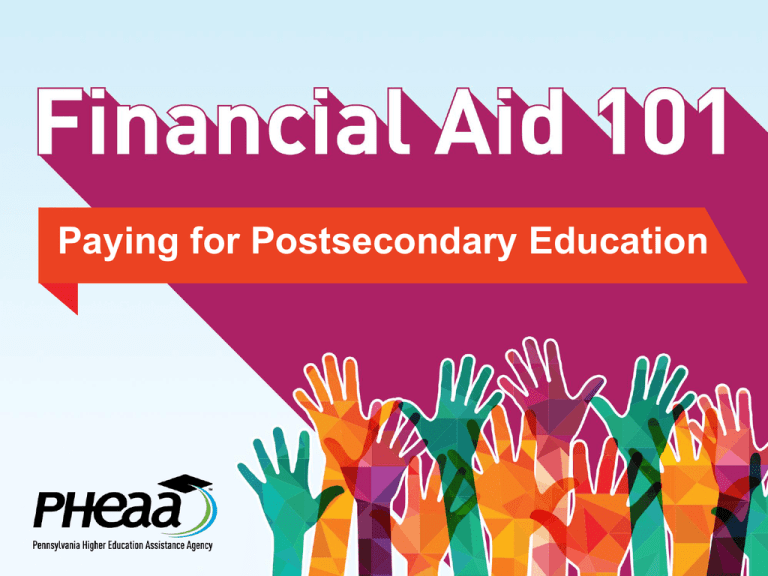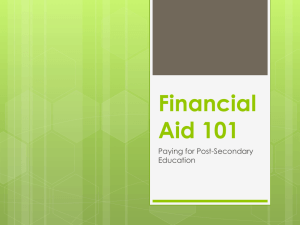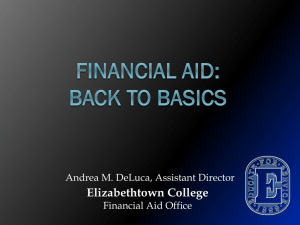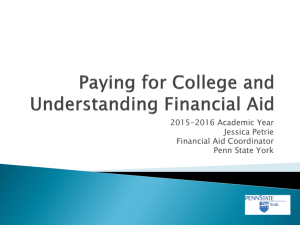Financial Aid PowerPoint
advertisement

Paying for Postsecondary Education What We’ll Cover Today’s Agenda Applying for Financial Aid Identify what is needed What aid sources are available What happens next Making smart decisions Latest Headlines and Trends A Recent Survey Says… HAVE YOU RULED OUT OR WILL YOU RULE OUT ANY COLLEGES BASED ON THEIR “STICKER” PRICE? NO YES I DON’T KNOW YET “2014 Rising Seniors’ Perceptions on Financial Aid,” produced by Ruffalocody Enrollment Management, in conjunction with Scannell & Kurz 45% 40% 15% Financial Aid Basics What Is Financial Aid? • Financial aid consists of funds provided to students and families to help pay for postsecondary educational expenses. • Grants/Scholarships (free money) • Self-Help (work, savings, etc.) • Loans Basic Principles • Paying is the joint responsibility of the student and parent(s), to the extent possible. • Need-based financial aid is subject to federal formula to determine financial need. • Not all families qualify for need-based aid. There is no guarantee that you will get any free money to pay for higher education. Where Does the Money Come From? • Federal Government • State Government • School/Colleges • Private Scholarship Sources: » HS counselors » Clubs and organizations » Employers » Internet scholarship searches Scholarships Scholarship search: • Start early – and KEEP LOOKING • GOOGLE your interests • Don’t PAY for information • Criteria varies by school » If you’re asked to pay, it’s not free money - (SCAM) • Don’t fear ESSAYS • Small scholarships ADD UP • Don’t miss DEADLINES • Write it down! Don’t miss out on FREE Money! FastWeb.com EducationPlanner.org Chegg.com FinAid.org ScholarshipExperts.com Scholarships.com Scholarship-Page.com DoSomething.org/Scholars hips Colleges.Niche.com StudentScholarships.org BigFuture.Collegeboard.org CollegeAnswer.com CollegeNet.com MeritAid.com MORE…. Recognize Scholarship Scams 1. Application Fees • Even if the fee is minimal or “only to encourage serious students to apply” 2. “Guaranteed” Scholarships • No individual can honestly “guarantee” you’ll win free money 3. Solicitations • “You’ve been selected…” • “You are a finalist…” • Bona fide companies won’t ask for a check or credit card payment upfront (Ebony.com, quoting the Better Business Bureau) 4. Official-looking Companies • The logo may look like the U.S. Dept. of Education’s logo • The company may talk about “federal” or “national” awards 5. Seminars • Don’t get pressured into paying for services on the spot. fastweb.com • Excellent site to use for searching as it is a database that pulls specific scholarships for students based on their input. It also sends email alerts when a scholarship matches the student. • Largest, most accurate and most frequently updated scholarship database. • FastWeb.com Federal and State Aid Federal Programs • Pell Grant (2015-16 max award $5,775)* • Campus-based aid – amounts determined by FAO » FSEOG………………… up to $4,000 » Perkins Loan….……….. up to $5,500 (undergraduate) » Federal Work-Study…… FAO determines • For most programs, student must be enrolled at least half-time. * Goes to most financially needy students Federal Work-Study Students who participate in the federal work-study program are more likely to graduate and be employed 6 years after college than their similar counterparts who don’t participate in the program, according to a new study. Inside Higher Ed reports Study conducted by two Columbia University researchers, Judith Scott-Clayton and Veronica Minaya Other Federal Programs Please check out this website to see all federal aid sources: StudentAid.ed.gov/types Pennsylvania State Grant* • In-state (PA) - Full-time up to $4,340 • In-state (PA) – Part-time 1/2 of the FT award • Out-of-state - Up to $600 in DC, DE, MA, OH, RI, VT, WV • Amount determined in part by the cost of the school * Must be at least half-time to be eligible Other State Programs • State Work-Study - job related to major • Educational Assistance Grant (EAP) – National Guard • Chafee Education and Training Grant – co-administered with the PA Department of Human Services • Blind or Deaf Beneficiary Grant • Postsecondary Educational Gratuity Program (PEGP) • Partnerships for Access to Higher Education (PATH) • Pennsylvania Targeted Industry Program (PA –TIP) • Ready to Succeed Scholarship (RTSS) • For details, see the PA Student Aid Guide, or visit PHEAA.org. Federal Loans A Recent Survey Says… ARE YOU GOING TO BORROW FOR YOUR UNDERGRADUATE DEGREE? PLANNING TO BORROW I DON’T KNOW NOT PLANNING TO BORROW “2014 Rising Seniors’ Perceptions on Financial Aid,” produced by Ruffalocody Enrollment Management, in conjunction with Scannell & Kurz 48% 43% 9% Federal Direct Loan Program • Available to ALL students REGARDLESS of need • Additional unsubsidized funds available for Independent & Parent PLUS denials » 4.29% variable/fixed interest rate (AY 15/16), 1.068% fee » Rates set every July 1st for the life of that year’s loan; fees are deducted from disbursement • AWARDED to every eligible undergraduate student • In student’s name, no collateral or credit check, must sign MPN • Available loan amounts increase in subsequent years • No payments required while attending school & 6-month grace period • 150% RULE applies – New borrowers as of 7/1/13 StudentLoans.gov & school’s website! Based on FAFSA, students have a combination of: • Subsidized = govt pays interest in school and grace status • Unsubsidized = interest accrues in school and grace Federal Student Loans • No credit check • Annual and aggregate borrowing limits • Fixed interest rate • Rate for new loans is reset every July 1st • Rate is based on 10-year Treasury note (+2.05%) • 6-month grace period • 10-year standard repayment • Flexible repayment options Interest Rates – Student Loans • Undergraduate – Subsidized and Unsubsidized: » 4.29% for 2015-16 » Capped at 8.25% • Graduate – Unsubsidized Only: » 5.84% for 2015-16 » Capped 9.50% PLUS and GradPLUS • Parent & GradPLUS » 6.84% for 2015-16 » Capped at 10.50 % » Up-front fee of 4.292% deducted at disbursement • May borrow up to full cost of education minus financial aid • Credit check is required on this loan Federal Direct PLUS (Parent) • Repayment begins immediately - can defer repayment until 6 months after student graduates or drops below half-time enrollment » If defer payment – encouraged to make interest payments » Standard repayment is 10 years Benefits of Paying Interest • Paying now will reduce what is capitalized! • Interest accrues on your unsubsidized student loan and Federal PLUS Loan: » Every day, from the day the loan is disbursed until you make the last payment » Even if your loan is not in repayment • Interest accrues on your subsidized student loan: » Every day, from the day the repayment period starts until you make the last payment Federal Direct Loan Aggregate Limits Undergraduate Education (Dependent Student) Undergraduate Education (Independent Student OR Dependent Students whose Parents were denied PLUS Loan) Graduate / Professional Education $31,000 ($23,000 maximum Subsidized Loan) $57,500 ($23,000 maximum Subsidized Loan) $138,500 Private/Alternative Loans Consider these ONLY after looking into all other sources of financial aid Forms Starting the Financial Aid Process Know what financial aid forms each school requires ALL Schools Require: • FAFSA (Free Application for Federal Student Aid) after Jan 1 in Sr. Year » • Required by all schools, PHEAA, and some scholarship organizations STATE GRANT FORM (SGF) through PHEAA » Required for first-year students (and may be requested for subsequent years) = after FAFSA is completed SOME Schools Require: • CSS Profile required by some postsecondary schools and scholarship organizations • Institutional financial aid forms • Internal school forms FAFSA – Free Application for Federal Student Aid FAFSA.gov • FAFSA is the primary federal form for financial assistance to attend postsecondary school • It determines: » Expected family contribution, need » Eligibility for most aid programs • Must file a FAFSA to be eligible for these programs each year a student attends school • File online – Fast, Secure, SKIP LOGIC and Built-in Edits • Want practice? Visit FAFSA4CASTER Deadlines Are Crucial • Make sure you know the priority FAFSA filing deadlines for the schools you are researching. • File your FAFSA prior to the earliest deadline, even if you have to estimate your financial information. You can always update the FAFSA later. Electronic Signature: Create an FSA User ID and Password: • NEW - Replaces the “PIN” as of 5/10/15 • Student and one parent will sign the FAFSA electronically - each needs a SEPARATE email address and ID/password • A verification process delays use – Get your ID/password early • A FAFSA IS NOT COMPLETE UNTIL SIGNED! You’ll use it again for: • Renewal FAFSA • FAFSA status and corrections • Signing a Direct Loan Master Promissory Note (MPN) • Complete required entrance and exit loan counseling • Review loan history at NSLDS.ed.gov FAFSA TIPS Don’t mix answers for student and parent information Ensure SSN accuracy Gender question is optional – answer it! Have federal income tax and other related information to use as references It’s OK TO ESTIMATE if taxes aren’t filed yet » Updates/corrections can be done later using the IRS Data Retrieval Tool Don’t delay, don’t miss deadlines FAFSA Completion Page • Apply for your State Grant from the FAFSA Completion/Confirmation page • Start your state application to apply for Pennsylvania state based financial aid • TRANSFERS FOTW data to the State Grant Application Online State Grant Application • Link off the FAFSA Application Confirmation Page » Missed the link or it wasn’t available? • • • Link in an email sent to student/parent from PHEAA, OR Go to PHEAA.org; State Grant Program; and complete the form Additional questions needed to determine PA State Grant eligibility: » » » » Enrollment status (full-time/part-time) Value of PA 529 College Savings Program Program of study for students in vocational programs Employment status Help screens are available for all questions Whose Info Goes on the FAFSA? • Divorced or separated parents (The parent the student lived with the most over the past 12 months. If equal, then the parent who provided more than 50% of student’s support) • Stepparents - YES • Adoptive parents - YES • Foster parents - NO • Legal guardians - NO • Anyone else the student is living with - NO Special Circumstances Recent death or disability Reduced income Recent separation or divorce Contact the school and ask for a special consideration AND contact State Grant Division at PHEAA Forms Are Filed – Now What? Expected Family Contribution (EFC) • The EFC is a number derived from a federal formula which considers a family’s income, assets and other factors. • In theory, the EFC is the amount a family can reasonably be expected to pay toward college expenses each year. • In reality, it is not the amount a family is required to pay and it is rarely the amount a family actually pays. How is the EFC Calculated? • Parent contribution + student contribution = EFC • Bulk of EFC comes from income • Home, personal property, qualified retirement funds, and value of life insurance excluded from assets • Asset protection allowance (based on age of older parent, or the parent if single parent household) • Parent asset contribution usually = roughly 6% • Student income contribution = 50% of amount over $6,400 • Student asset contribution = 20% of assets • Parent contribution divided by number of children in college at the same time What Happens Next? • Student Aid Report or Acknowledgment sent to student (review and make necessary corrections) • Information is sent to PHEAA. Student must complete State Grant Form (SGF). Can link to this directly from the FAFSA. • Account Access (PHEAA) - Create an account at PHEAA.org to view PA State Grant • Information is sent to schools/colleges. Send to all schools being considered. Calculating Financial Need Schools/colleges receive financial aid information and calculate financial need • Financial Aid Office (FAO) “packages” student based on financial need and available funding (varies from school to school) • Financial aid award letter sent to student School cost $26,000 EFC –$3,000 Financial Need $23,000 What School Costs are Considered? • School costs include: Tuition and fees Room and board Books and supplies Transportation Miscellaneous living expenses Child care, if necessary You can receive financial aid up to the total of the school regardless of your EFC! Financial Aid Award Letter • Official notification from school about financial aid, terms and conditions • Lists the type and amount of each award to be received • Describes what must be done to accept or reject any award • Discloses students rights, responsibilities and academic requirements Reviewing the Financial Aid Package • After reviewing their packages, students should be sure they know and understand the following: » How much of the financial aid is free money? » Which awards are based on need, and which are based on merit? » Are there any conditions on the free money; in particular, is there a GPA requirement? » Will awards change from year to year? » Will institutional awards increase as tuition increases? » Will loans be needed? If so, how much? Comparing Packages Cost $20,000 $30,000 $50,000 EFC $ 3,000 $ 3,000 $ 3,000 Need $17,000 $27,000 $47,000 Free Money $ 6,000 $ 8,000 $18,000 Loans $ 5,500 $ 7,000 $ 8,000 Work-Study $0 $ 2,000 $ 3,000 TOTAL AID $11,500 $17,000 $29,000 Gap = (Cost – Aid) $ 8,500 $13,000 $21,000 Actual Cont. = (Cost – Free $) $14,000 $22,000 $32,000 Smart Borrowing How Much Should I Borrow? • Estimate your full cost of school • Borrow only what you need • Research your earning potential • Don’t borrow more to get your education than you believe you can earn your first year in the workforce • Think long-term • Keep a healthy mindset about debt The Rule • Don’t borrow more to get your education than you can reasonably expect to make during your very first year in the workforce. » Keep loan payment <12% of gross earnings MySmartBorrowing.org An interactive, online tool created by PHEAA that helps students and families: • Estimate career salaries & college tuition • View the impact of savings on overall cost • Calculate loan repayment • Avoid overborrowing MySmartBorrowing.org How it Works MySmartBorrowing guides students and families through four easy sections: Select a Career Factor in Savings Select a School Get Results Net Price Calculators The Higher Education and Opportunity Act (HEOA) of October 2011 requires schools to offer a Net Price Calculator on their websites • Enables current and prospective students, families and consumers to determine an estimate of an individual net price at a particular institution. • ESTIMATED data must be provided by each institution: » Total price of attendance » Tuition, Fees, Room and Board » Expenses (ie. personal, transportation) » Estimated total merit and need-based grant aid » Estimated net price (attendance minus grant aid) • Does not include scholarships Final Thoughts/Wrap-Up Beware of the 5-Year Plan Things like double majors, study abroad, internships, and athletics can enhance the educational experience and improve marketability. But it comes at a price: • Total cost just increased by 25% • The 5th year likely costs 20% more than the 1st year did • Loss of institutional funds if they only allow for 4 years • Loss of PA State Grant if all 4 years have been received • Reduction in student borrowing capacity if maximum loans received in the first 4 years (only $4,000 left) • Talk it over and plan ahead! Ways to Reduce the Need for Financial Aid • Graduate on Time » 4 year for bachelor’s degree / 2 year for associate’s degree • Research and find the right school and major » Minimize transfer and change of major • Earn college credits while in high school through AP courses, vo-tech and dual enrollment • Consider options for cutting costs (commute, take summer classes, buy used books, make smart meal plan choices) • 2 + 2 Strategy (2 years at a community college then transfer credits to a 4-year school) • 3 + 2 (master’s degree) Education: A Great Investment • Average loan payments for bachelor’s degree: about $300/mo for 10 years • Average additional earnings with higher education: about $2,100/mo for 40 years Resources Use Your Resources • PHEAA.org • EducationPlanner.org & MySmartBorrowing.org • YouCanDealWithIt.com • MyFedLoan.org • PHEAA toll free: 800.692.7392 • Federal Student Aid Info Center – 800.433.3243 • FAFSA.gov • StudentAid.gov – general financial aid info • StudentLoans.gov – information on federal loans Contact Information SONYA MANN-MCFARLANE smannmcf@pheaa.org QUESTIONS?



